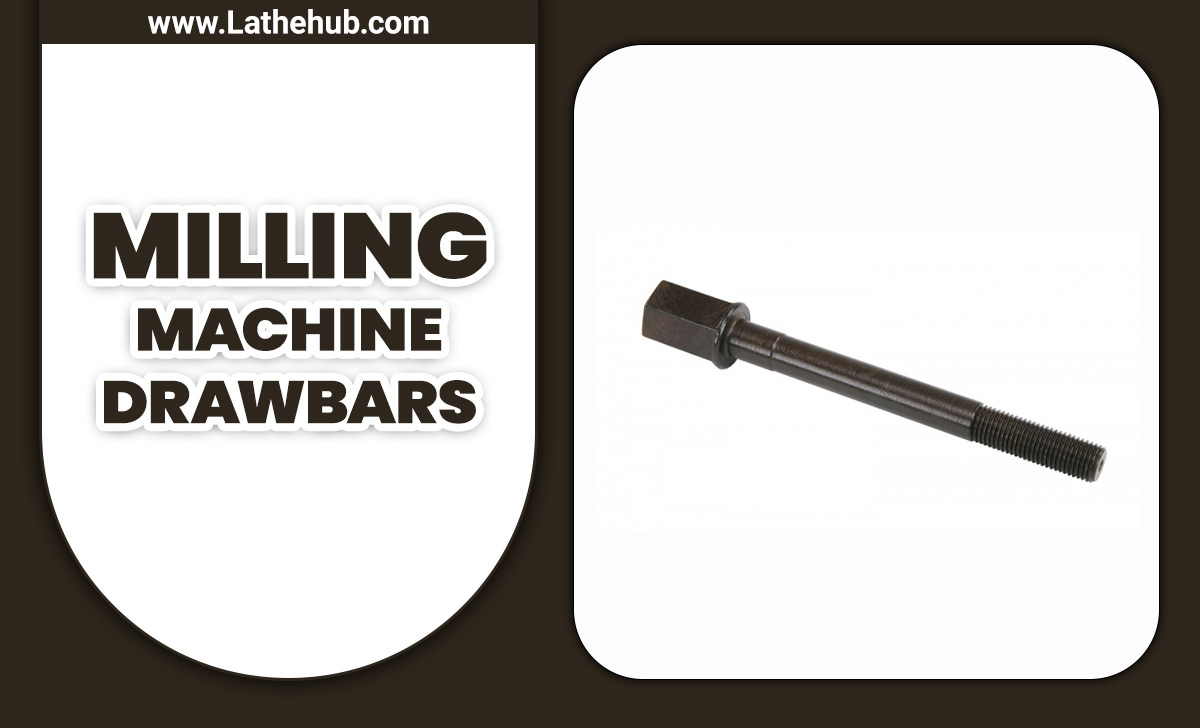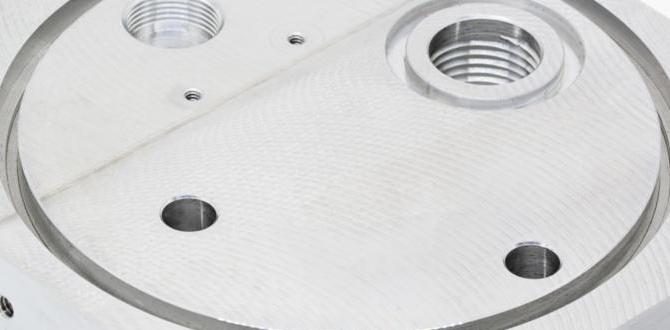Carbide end mills with 8mm shanks are fantastic for machining aluminum, offering precision, durability, and efficiency. This guide will show you how to choose and use the right one for your projects, making aluminum machining easier than ever.
So, you’re looking to machine some aluminum? That’s a great choice! Aluminum is relatively soft, easy to work with, and makes for fantastic finished parts. But if you’ve ever tried milling aluminum with the wrong tool, you know it can be a frustrating experience. Chips can gum up your cutter, leading to poor surface finish and even broken tools. That’s where a good carbide end mill, specifically one with an 8mm shank, becomes your best friend. Don’t worry if you’re new to this; I’m Daniel Bates from Lathe Hub, and I’m here to break down exactly why an 8mm shank carbide end mill is so essential for aluminum and how to use it effectively. We’ll cover everything from selecting the right type to getting the best results without any fuss.
Why the 8mm Shank for Aluminum is a Game-Changer
When you’re starting out in milling, especially with softer metals like aluminum, the tools you choose make a huge difference. You want something that can handle the material, give you clean cuts, and last a good long time. This is where carbide end mills shine, and the 8mm shank size has some specific advantages for aluminum work.
The Brilliance of Carbide
First off, let’s talk about carbide. Unlike traditional High-Speed Steel (HSS) cutters, carbide is much harder and can withstand higher temperatures caused by faster cutting speeds. This means you can generally run your mill faster with carbide, which translates to quicker machining times. For aluminum, this is ideal because it allows for the efficient removal of material while minimizing the risk of chip welding – that sticky situation where aluminum chips melt onto the cutter.
The 8mm Shank Advantage
Now, why 8mm specifically? This size hits a sweet spot for many common CNC and manual milling operations, especially on entry-level or hobbyist machines.
- Rigidity: A larger shank diameter, like 8mm (which is roughly 0.315 inches), provides more rigidity than smaller shanks (like 3mm or 4mm). This increased stiffness is crucial for preventing tool deflection, especially when cutting deeper or taking heavier passes. Less deflection means more accurate parts.
- Tool Holder Compatibility: Many popular ER collet chucks and tool holders for smaller milling machines are designed to accommodate standard shank sizes, and 8mm is very common. This makes it easy for hobbyists and DIYers to find compatible holders.
- Balance of Strength and Size: While a 1/4″ (6.35mm) shank is common, an 8mm shank offers a noticeable increase in rigidity without being so large that it requires massive tool holders or machines. It’s a practical compromise for many applications.
- Access to a Wide Range of Cutters: You’ll find a vast selection of 8mm shank carbide end mills available specifically designed for aluminum, in various flute counts and geometries. This wide availability means you can find the perfect tool for your specific task.
Aluminum Alloys and the 8mm Shank
Aluminum isn’t just one thing; it comes in many alloys, with 6061-T6 being one of the most popular for machining due to its excellent strength-to-weight ratio and corrosion resistance. When machining 6061, you want a tool that can effectively clear chips and handle the slightly gummy nature of the alloy. An 8mm, standard-length carbide end mill is well-suited for this, providing enough support to maintain accuracy on precise cuts.
Choosing Your 8mm Carbide End Mill for Aluminum
Selecting the right end mill is more than just grabbing the first one you see. For aluminum, certain features will make your life much easier.
Flute Count: The Key to Chip Clearance
Flutes are the spiral grooves on the end mill. For aluminum, flute count is critical for managing chips.
- 2 Flutes: These are often the go-to for aluminum. The two large open flutes provide maximum space for chips to evacuate. This is vital for aluminum because if chips aren’t cleared, they can melt onto the cutter and ruin your work.
- 3 Flutes: While often used for steel or cast iron, 3-flute end mills can sometimes be used for aluminum, especially if you’re taking lighter cuts or using a specialized high-feed aluminum geometry. They offer a slightly smoother finish than 2-flutes but can be more prone to chip packing if not managed carefully.
- 4 Flutes: Generally not recommended for soft, gummy materials like aluminum. The smaller chip relief per flute makes them very prone to chip welding and poor performance.
Recommendation for Aluminum: Start with a 2-flute end mill.
Coating: Enhancing Performance
While many end mills for aluminum are uncoated, special coatings can offer benefits.
- Uncoated: For aluminum, uncoated carbide is often excellent. The natural lubricity of the polished carbide surface helps prevent chips from sticking.
- ZrN (Zirconium Nitride): This is a good coating for aluminum. It’s a gold-colored coating that provides excellent lubricity and reduces friction, further helping to prevent chip buildup.
- TiCN (Titanium Carbonitride): While tougher, TiCN is generally not the best choice for aluminum as it can sometimes increase friction and the tendency for aluminum to stick.
Recommendation for Aluminum: Uncoated or ZrN coated.
Geometry: Aluma-Specific Designs
Some end mills are specifically designed for aluminum. These often feature:
- Polished Flutes: To reduce friction and aid chip evacuation.
- Sharp Cutting Edges: Essential for clean cuts in soft metals.
- Large Helix Angle: A steeper helix angle (often 40-45 degrees) helps to efficiently curl and eject chips.
Length and Diameter
For this guide, we’re focusing on the 8mm shank. The diameter of the end mill itself will vary depending on your project needs. For general-purpose work and tight tolerance applications, a standard length end mill is usually perfect. Avoid “long reach” or “extra long” end mills unless absolutely necessary, as they are less rigid and more prone to deflection.
Key Specifications to Look For (SEO Focus)
When searching online for your perfect tool, keep these terms handy for precise results:
- Carbide End Mill
- 8mm Shank
- 2 Flute (for aluminum)
- Aluminum / Soft Metals
- Standard Length
- Tight Tolerance (if precision is paramount)
- 6061 Aluminum (if this is your primary material)
These keywords will help you find the most suitable carbide end mill 1/8 inch 8mm shank standard length for aluminum 6061 tight tolerance, even though you’re looking for an 8mm shank (which is not 1/8 inch, but often a common alternative size in metric systems). It’s important to note the subtle difference: 8mm is approximately 0.315 inches, while 1/8 inch is 0.125 inches. You’re looking for the 8mm shank!
Setting Up Your Machine for Success
Before you even think about cutting, proper setup is key. This reduces vibration, ensures accuracy, and keeps you safe.
Tool Holder and Collet Selection
Ensure your collet and tool holder are the correct size for the 8mm shank. A loose fit is dangerous and leads to poor results. ER collet chucks are common and work well. Make sure the collet is clean and free of debris. For tight tolerances, using a high-quality, well-balanced tool holder is essential.
Workholding: Holding Your Aluminum Securely
Your aluminum workpiece needs to be held firmly. A vise is the most common method for hobbyists.
- Use soft jaws if you’re concerned about marring the surface of your aluminum.
- Ensure the workpiece is seated flat against the vise or fixture.
- Apply enough clamping force to prevent any movement during machining.
Machine Rigidity
While an 8mm shank adds rigidity to the tool, your milling machine itself needs to be capable. Ensure your machine is in good working order, with no excessive play in the axes. A sturdy, well-maintained benchtop mill or a larger machine will yield better results than a wobbly setup.
Machining Aluminum with Your 8mm End Mill: Basic Techniques
Let’s get to the good part – making chips! Here’s a breakdown of how to approach milling aluminum.
Cutting Parameters: Speed and Feed Rate
This is where things get exciting and where you can really see the benefits of carbide. The exact numbers depend on your machine, the specific aluminum alloy, and the end mill, but here are general guidelines for a typical 2-flute, 8mm carbide end mill cutting 6061 aluminum:
- Spindle Speed (RPM): For uncoated carbide in aluminum, you can often start around 12,000-20,000 RPM. Coated tools might allow even higher speeds. Always check the tool manufacturer’s recommendations if available.
- Feed Rate: This is how fast the tool moves into the material. A good starting point for a chip load (amount of material removed by each cutting edge per revolution) of 0.002 – 0.004 inches per tooth (IP T) is common. For an 8mm end mill (approx. 0.315 inches), this can translate to a feed rate of around 40-80 inches per minute (IPM). Again, start conservatively and adjust.
Important Note on Chip Load: Chip load is a crucial concept. It’s the thickness of the chip each tooth cuts. Too small, and you’ll rub and rub, leading to tool wear and poor finish. Too large, and you risk overloading the tool and breaking it.
Calculation example for chip load:
Feed Rate (IPM) = Spindle Speed (RPM) Number of Flutes Chip Load (IPT)
Let’s say:
Spindle Speed = 15,000 RPM
Number of Flutes = 2
Chip Load (IPT) = 0.003 inches
Feed Rate = 15,000 2 0.003 = 90 IPM
Clearing Cuts: The Heart of Aluminum Machining
Because aluminum chips can be problematic, how you remove material is as important as the speed you cut.
- Stepover (Width of Cut): This is how much the end mill overlaps from one pass to the next. For aluminum, a smaller stepover (e.g., 20-40% of the tool diameter) is often good for maintaining a smooth surface finish and managing heat.
- Stepdown (Depth of Cut): How deep you cut into the material in one pass. For an 8mm end mill, you can often take a decent depth of cut in aluminum, but it’s wise to start with a depth of around half the tool diameter (e.g., 4mm) and adjust based on your machine’s rigidity and the tool’s performance.
- High-Speed Machining (HSM) Principles: For aluminum, applying HSM principles can be very effective. This involves using higher spindle speeds and feed rates with light depths of cut and stepovers. This creates smaller, continuous chips that are easily evacuated, generating less heat and reducing tool wear.
Lubrication and Coolant
While some machinists run dry, a cutting fluid or lubricant can greatly improve your results with aluminum.
- Mist Coolant: A mist system sprays a fine mist of coolant and air. This is excellent for aluminum as it lubricates and also blows chips away.
- Flood Coolant: A flood system provides more robust cooling and chip flushing, ideal for heavier cuts.
- Cutting Paste/Fluid: For manual machines or lighter jobs, a dab of specialized cutting paste or fluid applied to the cutting area can help.
Authoritative Resource: For more detailed information on machining parameters, check out resources from organizations like the National Institute of Standards and Technology (NIST). While they don’t offer consumer guides, their fundamental research underpins machining best practices. For practical guides, resources like the Machinery’s Handbook (a widely respected reference book in machining, though not a direct link, it’s identifiable and authoritative) are invaluable.
Common Problems and How to Solve Them
Even with the right tools, you might encounter hiccups. Here’s how to troubleshoot.
Problem: Chips Welding to the End Mill
This is the bane of machining aluminum.
- Cause: Insufficient chip evacuation, too slow cutting speeds, or too much heat buildup.
- Solution:
- Increase spindle speed.
- Reduce feed rate slightly to ensure a proper chip load.
- Use a 2-flute end mill with polished flutes.
- Ensure coolant/lubricant is being used effectively.
- Reduce depth of cut and stepover to see if chip formation improves.
Problem: Poor Surface Finish
Scalloped or rough surfaces.
- Cause: Tool deflection, worn tool, incorrect cutting parameters, machine vibration.
- Solution:
- Ensure the tool is sharp and unworn.
- Check for excessive tool runout or play in the spindle.
- Use a smaller stepover percentage.
- Increase stiffness: use a shorter tool if possible, ensure workpiece is held very firmly.
- Reduce feed rate if it’s too high.
Problem: Tool Chattering or Vibrating
You can hear or feel the tool vibrating.
- Cause: Machine rigidity issues, loose workholding, incorrect cutting parameters (often feed too slow for spindle speed).
- Solution:
- Secure your workpiece and tool holder more firmly.
- Reduce the depth of cut.
- Increase the feed rate or decrease the spindle speed while maintaining a good chip load.
- Ensure there is no play in your machine’s axes.
Table: Carbide End Mill Features for Aluminum
Here’s a quick reference for what to look for in your 8mm shank end mill for aluminum.
| Feature | Ideal for Aluminum | Why? |
|---|---|---|
| Flute Count | 2 Flutes (Primarily) | Maximizes chip clearance, reduces chip welding. |
| Shank Diameter | 8mm (or 3/8 inch) | Good rigidity for a balance of strength and common tool holder compatibility. |
| Material | Solid Carbide | Superior hardness and heat resistance for faster cutting. |
| Coating | Uncoated or ZrN | Lubricity prevents aluminum from sticking, good heat resistance. |
| Flute Finish | Polished | Reduces friction and aids chip evacuation. |
| Helix Angle | 40-45 Degrees (High) | Helps curl and eject chips efficiently. |
| Length | Standard | Maximizes tool rigidity, minimizes deflection. |
Beyond Aluminum: Versatility of the 8mm Shank
While we’re focusing on aluminum, the 8mm shank carbide end mill is a versatile tool. Once you’re comfortable with it, you can explore milling other materials by adjusting your parameters and potentially switching to end mills with different flute counts and coatings. For instance, a 4-flute, TiCN coated, or uncoated carbide end mill with a lower helix angle would be more appropriate for steels. This foundational understanding of end mill selection and machining principles will serve you well as you expand your machining skills.
Safety First! Always
Machining involves powerful forces and sharp tools. Safety should always be your top priority.
- Always wear safety glasses. Flying chips are dangerous.
- Keep hands and loose clothing away from moving parts.
- Ensure your workpiece is securely fixtured before starting any cut.
- Never leave a running machine unattended.
- Understand your machine’s emergency stop procedures.
- Use appropriate cutting fluids and ventilation if required.
Frequently Asked Questions (FAQ)
Q: Is an 8mm shank end mill suitable for steel?
A: While an 8mm shank provides good rigidity, end mills designed for steel typically have higher flute counts (3 or 4 flutes) and coatings like TiCN or AlTiN, along with different geometries suited for harder materials. You can often use an 8mm shank end mill for steel, but you’ll need to select the






